Child Development: Exploring the Impact of Building Block Play
VerifiedAdded on 2020/10/22
|15
|3035
|256
Report
AI Summary
This report delves into the significant role of building block activities in child development. It explores how these activities enhance various skills, including cognitive abilities (shape recognition, analytical thinking), motor skills (grasping, hand-eye coordination), social skills (interaction, cooperation), and language and intellectual skills (vocabulary, numeracy). The report details the activity description, the stages children go through during block play, and the skills developed through these games, such as collaboration, imagination, and problem-solving. Furthermore, it discusses supporting theories like Lev Vygotsky's social development theory, Arnold Gesell's maturation theory, and Lawrence Kohlberg's moral development theory, demonstrating how these theories underpin the benefits of block play. The report emphasizes the rationale for incorporating building games, their implementation plan, and potential improvements, concluding with a comprehensive overview of the positive impact of building blocks on children's overall growth and learning. The report also provides insights into the artifact implementation plan, rationale, and potential improvements.
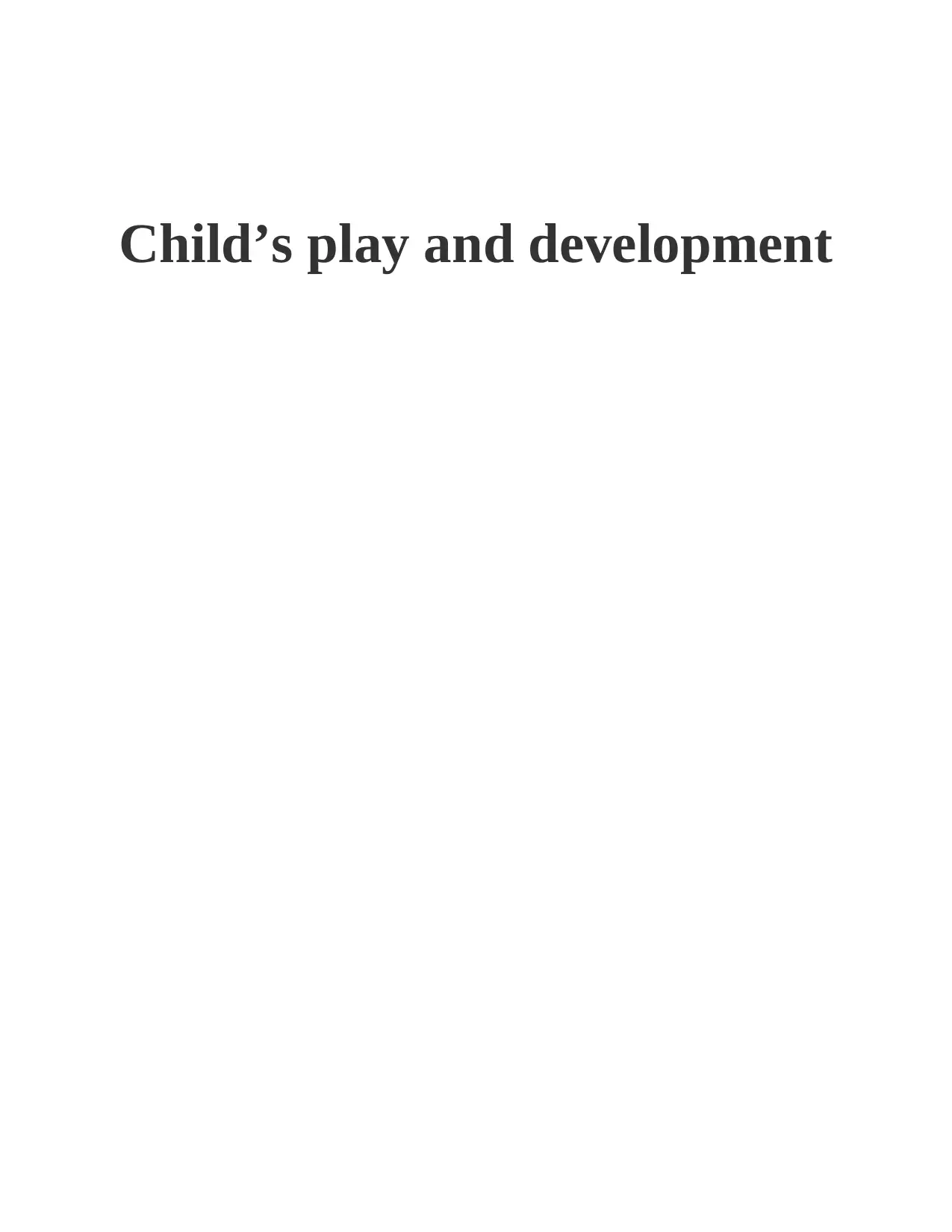
Child’s play and development
Paraphrase This Document
Need a fresh take? Get an instant paraphrase of this document with our AI Paraphraser
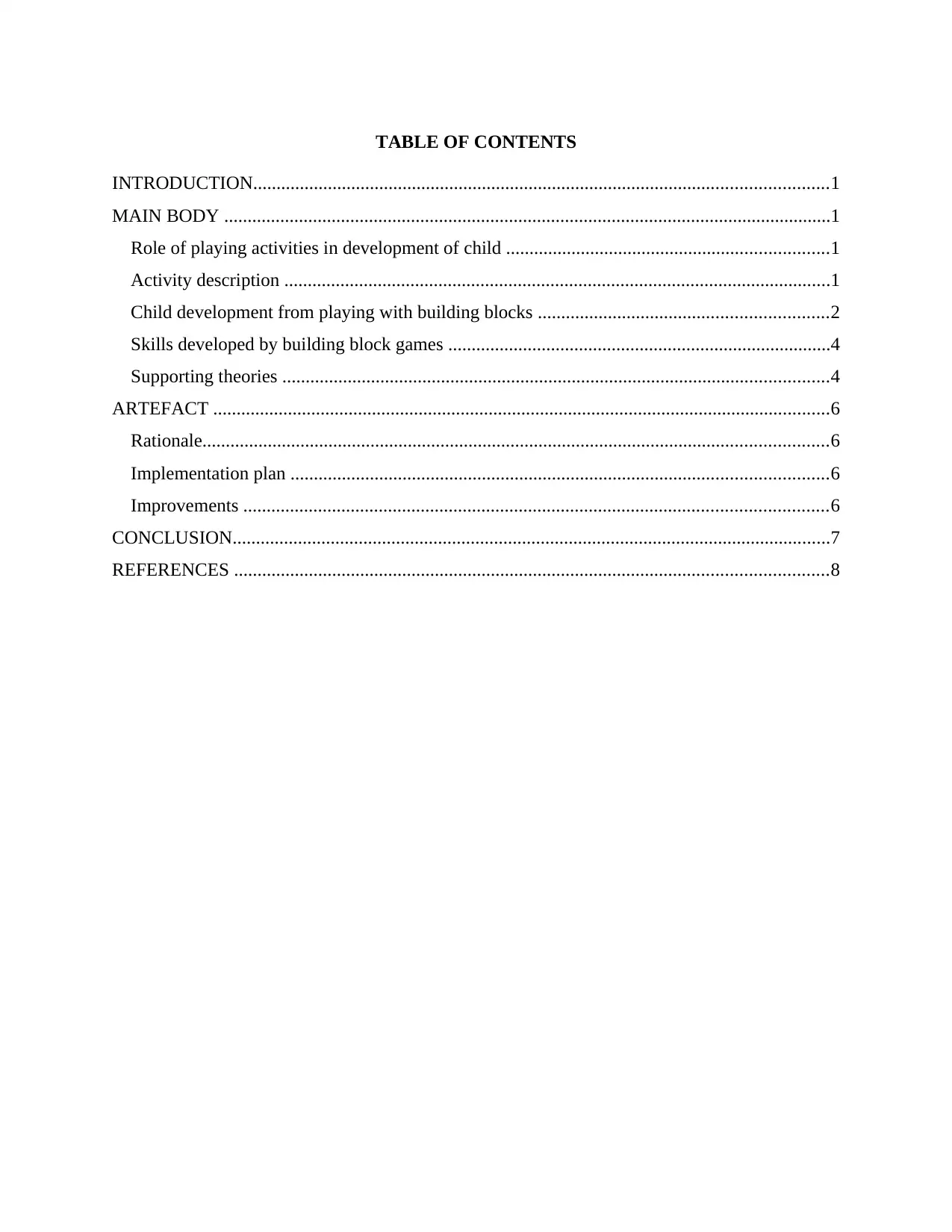
TABLE OF CONTENTS
INTRODUCTION...........................................................................................................................1
MAIN BODY ..................................................................................................................................1
Role of playing activities in development of child .....................................................................1
Activity description .....................................................................................................................1
Child development from playing with building blocks ..............................................................2
Skills developed by building block games ..................................................................................4
Supporting theories .....................................................................................................................4
ARTEFACT ....................................................................................................................................6
Rationale......................................................................................................................................6
Implementation plan ...................................................................................................................6
Improvements .............................................................................................................................6
CONCLUSION................................................................................................................................7
REFERENCES ...............................................................................................................................8
INTRODUCTION...........................................................................................................................1
MAIN BODY ..................................................................................................................................1
Role of playing activities in development of child .....................................................................1
Activity description .....................................................................................................................1
Child development from playing with building blocks ..............................................................2
Skills developed by building block games ..................................................................................4
Supporting theories .....................................................................................................................4
ARTEFACT ....................................................................................................................................6
Rationale......................................................................................................................................6
Implementation plan ...................................................................................................................6
Improvements .............................................................................................................................6
CONCLUSION................................................................................................................................7
REFERENCES ...............................................................................................................................8
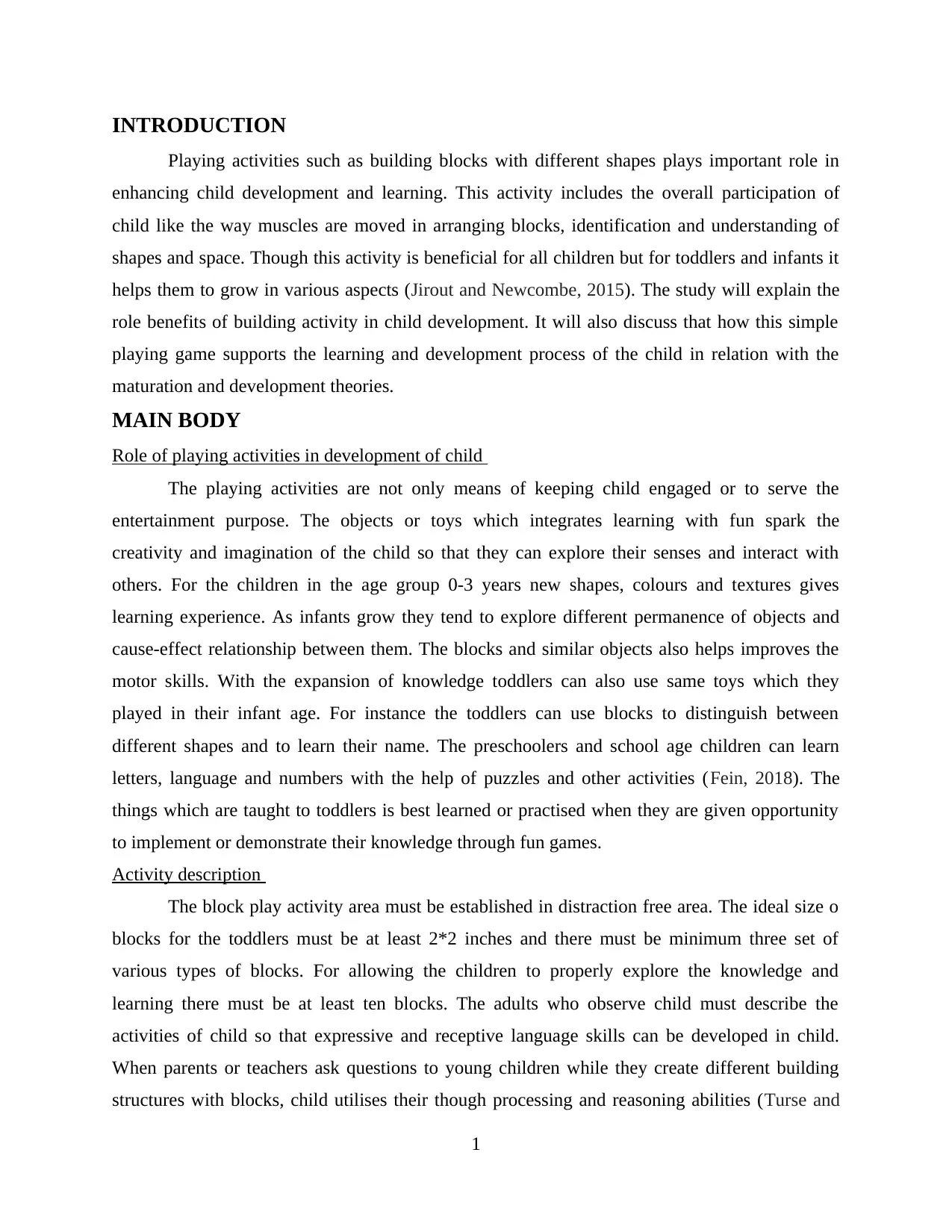
INTRODUCTION
Playing activities such as building blocks with different shapes plays important role in
enhancing child development and learning. This activity includes the overall participation of
child like the way muscles are moved in arranging blocks, identification and understanding of
shapes and space. Though this activity is beneficial for all children but for toddlers and infants it
helps them to grow in various aspects (Jirout and Newcombe, 2015). The study will explain the
role benefits of building activity in child development. It will also discuss that how this simple
playing game supports the learning and development process of the child in relation with the
maturation and development theories.
MAIN BODY
Role of playing activities in development of child
The playing activities are not only means of keeping child engaged or to serve the
entertainment purpose. The objects or toys which integrates learning with fun spark the
creativity and imagination of the child so that they can explore their senses and interact with
others. For the children in the age group 0-3 years new shapes, colours and textures gives
learning experience. As infants grow they tend to explore different permanence of objects and
cause-effect relationship between them. The blocks and similar objects also helps improves the
motor skills. With the expansion of knowledge toddlers can also use same toys which they
played in their infant age. For instance the toddlers can use blocks to distinguish between
different shapes and to learn their name. The preschoolers and school age children can learn
letters, language and numbers with the help of puzzles and other activities (Fein, 2018). The
things which are taught to toddlers is best learned or practised when they are given opportunity
to implement or demonstrate their knowledge through fun games.
Activity description
The block play activity area must be established in distraction free area. The ideal size o
blocks for the toddlers must be at least 2*2 inches and there must be minimum three set of
various types of blocks. For allowing the children to properly explore the knowledge and
learning there must be at least ten blocks. The adults who observe child must describe the
activities of child so that expressive and receptive language skills can be developed in child.
When parents or teachers ask questions to young children while they create different building
structures with blocks, child utilises their though processing and reasoning abilities (Turse and
1
Playing activities such as building blocks with different shapes plays important role in
enhancing child development and learning. This activity includes the overall participation of
child like the way muscles are moved in arranging blocks, identification and understanding of
shapes and space. Though this activity is beneficial for all children but for toddlers and infants it
helps them to grow in various aspects (Jirout and Newcombe, 2015). The study will explain the
role benefits of building activity in child development. It will also discuss that how this simple
playing game supports the learning and development process of the child in relation with the
maturation and development theories.
MAIN BODY
Role of playing activities in development of child
The playing activities are not only means of keeping child engaged or to serve the
entertainment purpose. The objects or toys which integrates learning with fun spark the
creativity and imagination of the child so that they can explore their senses and interact with
others. For the children in the age group 0-3 years new shapes, colours and textures gives
learning experience. As infants grow they tend to explore different permanence of objects and
cause-effect relationship between them. The blocks and similar objects also helps improves the
motor skills. With the expansion of knowledge toddlers can also use same toys which they
played in their infant age. For instance the toddlers can use blocks to distinguish between
different shapes and to learn their name. The preschoolers and school age children can learn
letters, language and numbers with the help of puzzles and other activities (Fein, 2018). The
things which are taught to toddlers is best learned or practised when they are given opportunity
to implement or demonstrate their knowledge through fun games.
Activity description
The block play activity area must be established in distraction free area. The ideal size o
blocks for the toddlers must be at least 2*2 inches and there must be minimum three set of
various types of blocks. For allowing the children to properly explore the knowledge and
learning there must be at least ten blocks. The adults who observe child must describe the
activities of child so that expressive and receptive language skills can be developed in child.
When parents or teachers ask questions to young children while they create different building
structures with blocks, child utilises their though processing and reasoning abilities (Turse and
1
⊘ This is a preview!⊘
Do you want full access?
Subscribe today to unlock all pages.

Trusted by 1+ million students worldwide
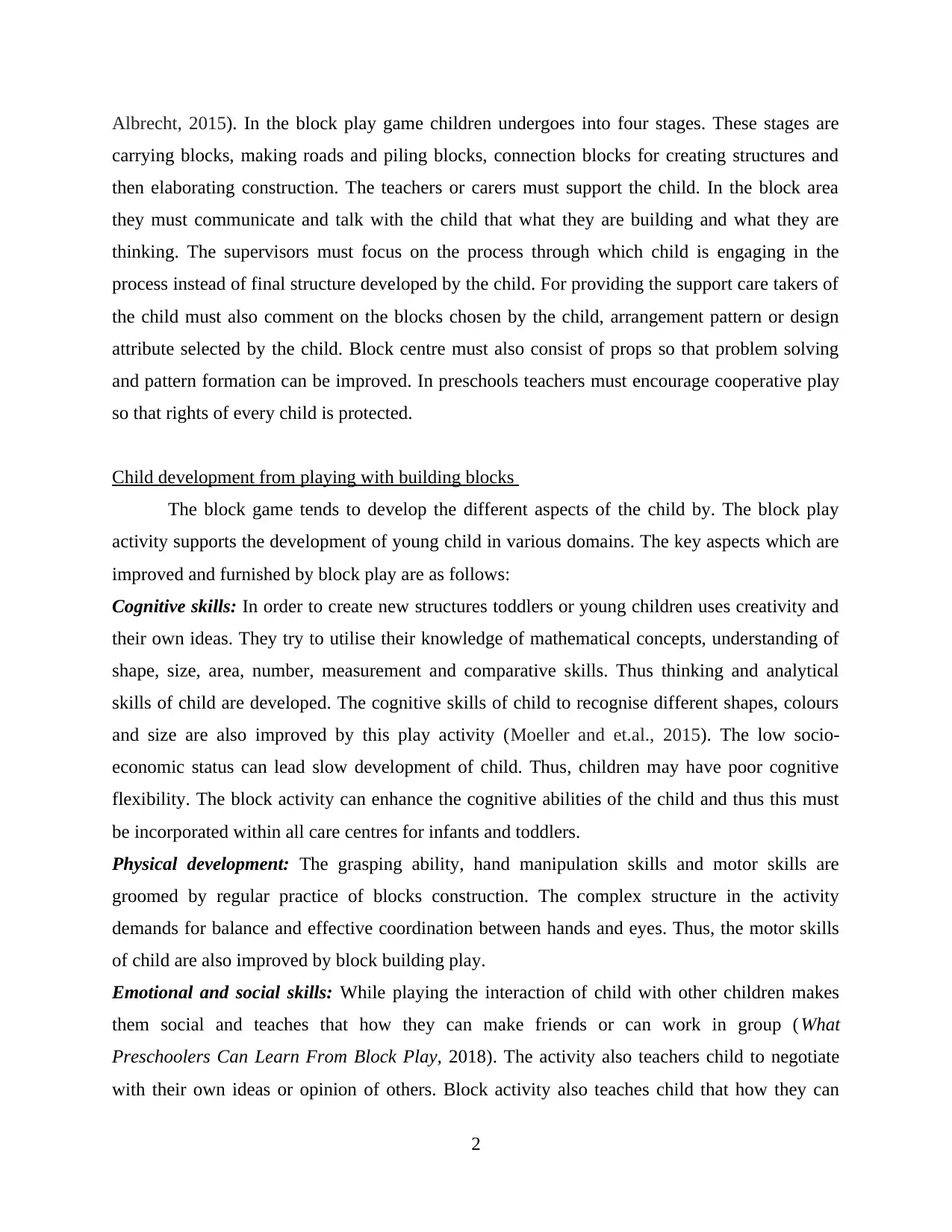
Albrecht, 2015). In the block play game children undergoes into four stages. These stages are
carrying blocks, making roads and piling blocks, connection blocks for creating structures and
then elaborating construction. The teachers or carers must support the child. In the block area
they must communicate and talk with the child that what they are building and what they are
thinking. The supervisors must focus on the process through which child is engaging in the
process instead of final structure developed by the child. For providing the support care takers of
the child must also comment on the blocks chosen by the child, arrangement pattern or design
attribute selected by the child. Block centre must also consist of props so that problem solving
and pattern formation can be improved. In preschools teachers must encourage cooperative play
so that rights of every child is protected.
Child development from playing with building blocks
The block game tends to develop the different aspects of the child by. The block play
activity supports the development of young child in various domains. The key aspects which are
improved and furnished by block play are as follows:
Cognitive skills: In order to create new structures toddlers or young children uses creativity and
their own ideas. They try to utilise their knowledge of mathematical concepts, understanding of
shape, size, area, number, measurement and comparative skills. Thus thinking and analytical
skills of child are developed. The cognitive skills of child to recognise different shapes, colours
and size are also improved by this play activity (Moeller and et.al., 2015). The low socio-
economic status can lead slow development of child. Thus, children may have poor cognitive
flexibility. The block activity can enhance the cognitive abilities of the child and thus this must
be incorporated within all care centres for infants and toddlers.
Physical development: The grasping ability, hand manipulation skills and motor skills are
groomed by regular practice of blocks construction. The complex structure in the activity
demands for balance and effective coordination between hands and eyes. Thus, the motor skills
of child are also improved by block building play.
Emotional and social skills: While playing the interaction of child with other children makes
them social and teaches that how they can make friends or can work in group (What
Preschoolers Can Learn From Block Play, 2018). The activity also teachers child to negotiate
with their own ideas or opinion of others. Block activity also teaches child that how they can
2
carrying blocks, making roads and piling blocks, connection blocks for creating structures and
then elaborating construction. The teachers or carers must support the child. In the block area
they must communicate and talk with the child that what they are building and what they are
thinking. The supervisors must focus on the process through which child is engaging in the
process instead of final structure developed by the child. For providing the support care takers of
the child must also comment on the blocks chosen by the child, arrangement pattern or design
attribute selected by the child. Block centre must also consist of props so that problem solving
and pattern formation can be improved. In preschools teachers must encourage cooperative play
so that rights of every child is protected.
Child development from playing with building blocks
The block game tends to develop the different aspects of the child by. The block play
activity supports the development of young child in various domains. The key aspects which are
improved and furnished by block play are as follows:
Cognitive skills: In order to create new structures toddlers or young children uses creativity and
their own ideas. They try to utilise their knowledge of mathematical concepts, understanding of
shape, size, area, number, measurement and comparative skills. Thus thinking and analytical
skills of child are developed. The cognitive skills of child to recognise different shapes, colours
and size are also improved by this play activity (Moeller and et.al., 2015). The low socio-
economic status can lead slow development of child. Thus, children may have poor cognitive
flexibility. The block activity can enhance the cognitive abilities of the child and thus this must
be incorporated within all care centres for infants and toddlers.
Physical development: The grasping ability, hand manipulation skills and motor skills are
groomed by regular practice of blocks construction. The complex structure in the activity
demands for balance and effective coordination between hands and eyes. Thus, the motor skills
of child are also improved by block building play.
Emotional and social skills: While playing the interaction of child with other children makes
them social and teaches that how they can make friends or can work in group (What
Preschoolers Can Learn From Block Play, 2018). The activity also teachers child to negotiate
with their own ideas or opinion of others. Block activity also teaches child that how they can
2
Paraphrase This Document
Need a fresh take? Get an instant paraphrase of this document with our AI Paraphraser
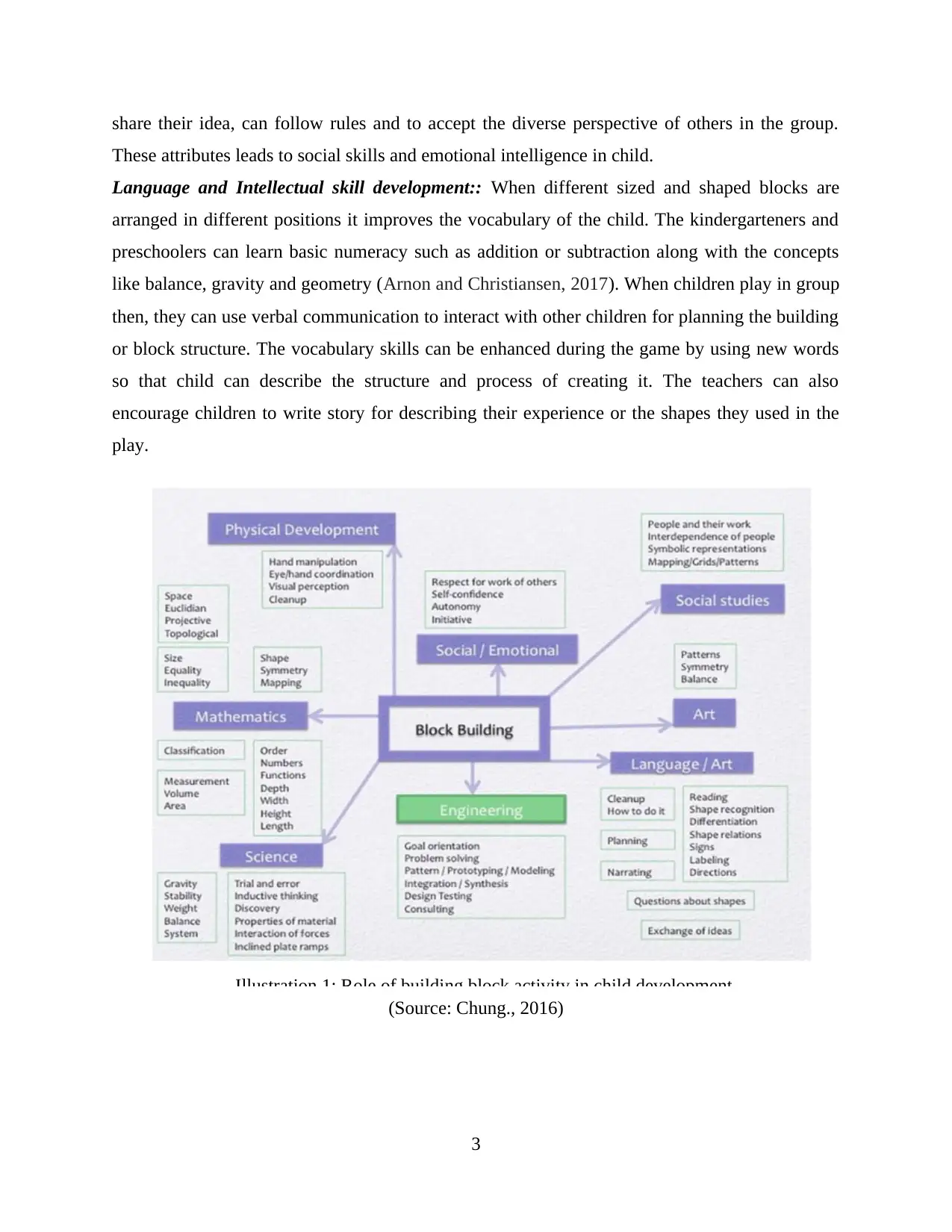
share their idea, can follow rules and to accept the diverse perspective of others in the group.
These attributes leads to social skills and emotional intelligence in child.
Language and Intellectual skill development:: When different sized and shaped blocks are
arranged in different positions it improves the vocabulary of the child. The kindergarteners and
preschoolers can learn basic numeracy such as addition or subtraction along with the concepts
like balance, gravity and geometry (Arnon and Christiansen, 2017). When children play in group
then, they can use verbal communication to interact with other children for planning the building
or block structure. The vocabulary skills can be enhanced during the game by using new words
so that child can describe the structure and process of creating it. The teachers can also
encourage children to write story for describing their experience or the shapes they used in the
play.
(Source: Chung., 2016)
3
Illustration 1: Role of building block activity in child development
These attributes leads to social skills and emotional intelligence in child.
Language and Intellectual skill development:: When different sized and shaped blocks are
arranged in different positions it improves the vocabulary of the child. The kindergarteners and
preschoolers can learn basic numeracy such as addition or subtraction along with the concepts
like balance, gravity and geometry (Arnon and Christiansen, 2017). When children play in group
then, they can use verbal communication to interact with other children for planning the building
or block structure. The vocabulary skills can be enhanced during the game by using new words
so that child can describe the structure and process of creating it. The teachers can also
encourage children to write story for describing their experience or the shapes they used in the
play.
(Source: Chung., 2016)
3
Illustration 1: Role of building block activity in child development
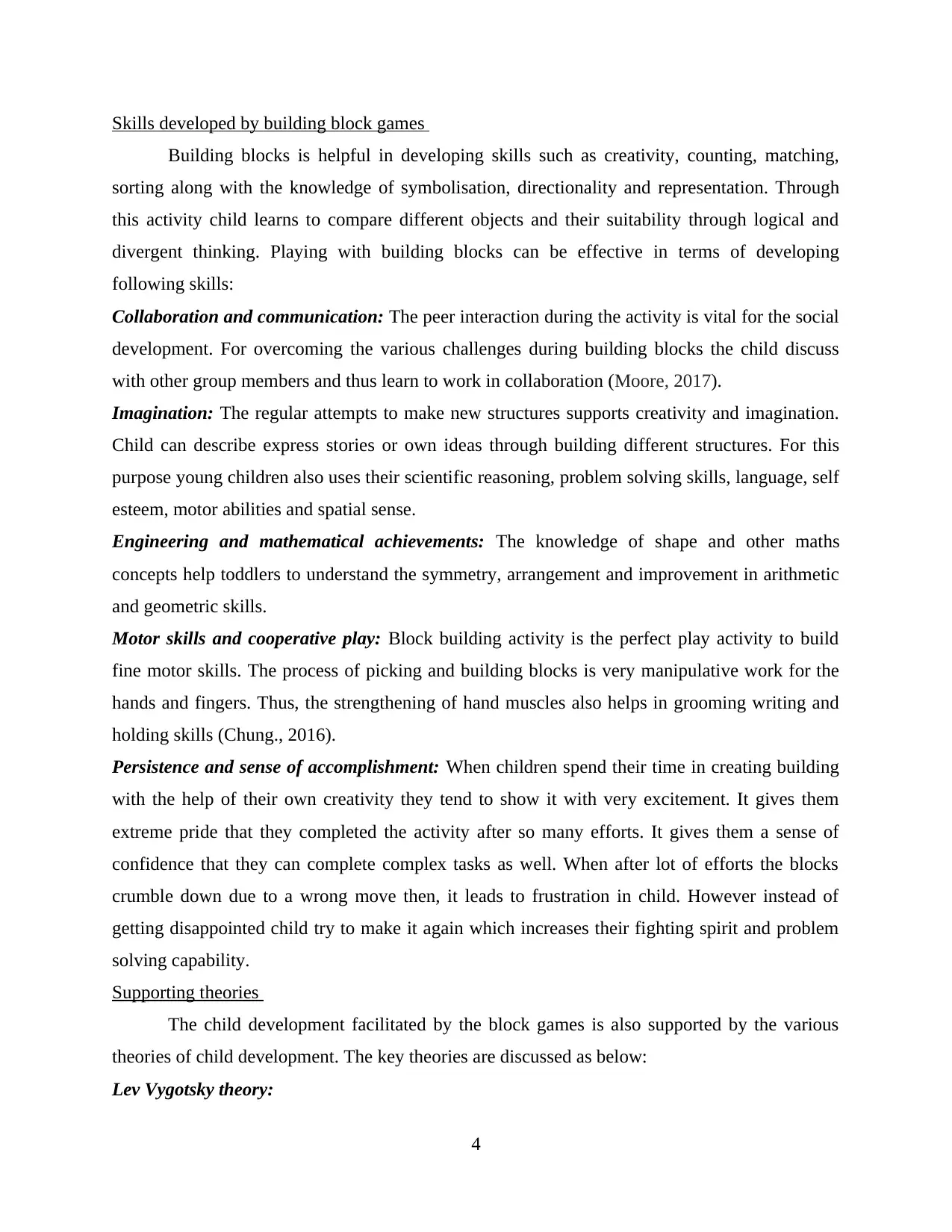
Skills developed by building block games
Building blocks is helpful in developing skills such as creativity, counting, matching,
sorting along with the knowledge of symbolisation, directionality and representation. Through
this activity child learns to compare different objects and their suitability through logical and
divergent thinking. Playing with building blocks can be effective in terms of developing
following skills:
Collaboration and communication: The peer interaction during the activity is vital for the social
development. For overcoming the various challenges during building blocks the child discuss
with other group members and thus learn to work in collaboration (Moore, 2017).
Imagination: The regular attempts to make new structures supports creativity and imagination.
Child can describe express stories or own ideas through building different structures. For this
purpose young children also uses their scientific reasoning, problem solving skills, language, self
esteem, motor abilities and spatial sense.
Engineering and mathematical achievements: The knowledge of shape and other maths
concepts help toddlers to understand the symmetry, arrangement and improvement in arithmetic
and geometric skills.
Motor skills and cooperative play: Block building activity is the perfect play activity to build
fine motor skills. The process of picking and building blocks is very manipulative work for the
hands and fingers. Thus, the strengthening of hand muscles also helps in grooming writing and
holding skills (Chung., 2016).
Persistence and sense of accomplishment: When children spend their time in creating building
with the help of their own creativity they tend to show it with very excitement. It gives them
extreme pride that they completed the activity after so many efforts. It gives them a sense of
confidence that they can complete complex tasks as well. When after lot of efforts the blocks
crumble down due to a wrong move then, it leads to frustration in child. However instead of
getting disappointed child try to make it again which increases their fighting spirit and problem
solving capability.
Supporting theories
The child development facilitated by the block games is also supported by the various
theories of child development. The key theories are discussed as below:
Lev Vygotsky theory:
4
Building blocks is helpful in developing skills such as creativity, counting, matching,
sorting along with the knowledge of symbolisation, directionality and representation. Through
this activity child learns to compare different objects and their suitability through logical and
divergent thinking. Playing with building blocks can be effective in terms of developing
following skills:
Collaboration and communication: The peer interaction during the activity is vital for the social
development. For overcoming the various challenges during building blocks the child discuss
with other group members and thus learn to work in collaboration (Moore, 2017).
Imagination: The regular attempts to make new structures supports creativity and imagination.
Child can describe express stories or own ideas through building different structures. For this
purpose young children also uses their scientific reasoning, problem solving skills, language, self
esteem, motor abilities and spatial sense.
Engineering and mathematical achievements: The knowledge of shape and other maths
concepts help toddlers to understand the symmetry, arrangement and improvement in arithmetic
and geometric skills.
Motor skills and cooperative play: Block building activity is the perfect play activity to build
fine motor skills. The process of picking and building blocks is very manipulative work for the
hands and fingers. Thus, the strengthening of hand muscles also helps in grooming writing and
holding skills (Chung., 2016).
Persistence and sense of accomplishment: When children spend their time in creating building
with the help of their own creativity they tend to show it with very excitement. It gives them
extreme pride that they completed the activity after so many efforts. It gives them a sense of
confidence that they can complete complex tasks as well. When after lot of efforts the blocks
crumble down due to a wrong move then, it leads to frustration in child. However instead of
getting disappointed child try to make it again which increases their fighting spirit and problem
solving capability.
Supporting theories
The child development facilitated by the block games is also supported by the various
theories of child development. The key theories are discussed as below:
Lev Vygotsky theory:
4
⊘ This is a preview!⊘
Do you want full access?
Subscribe today to unlock all pages.

Trusted by 1+ million students worldwide
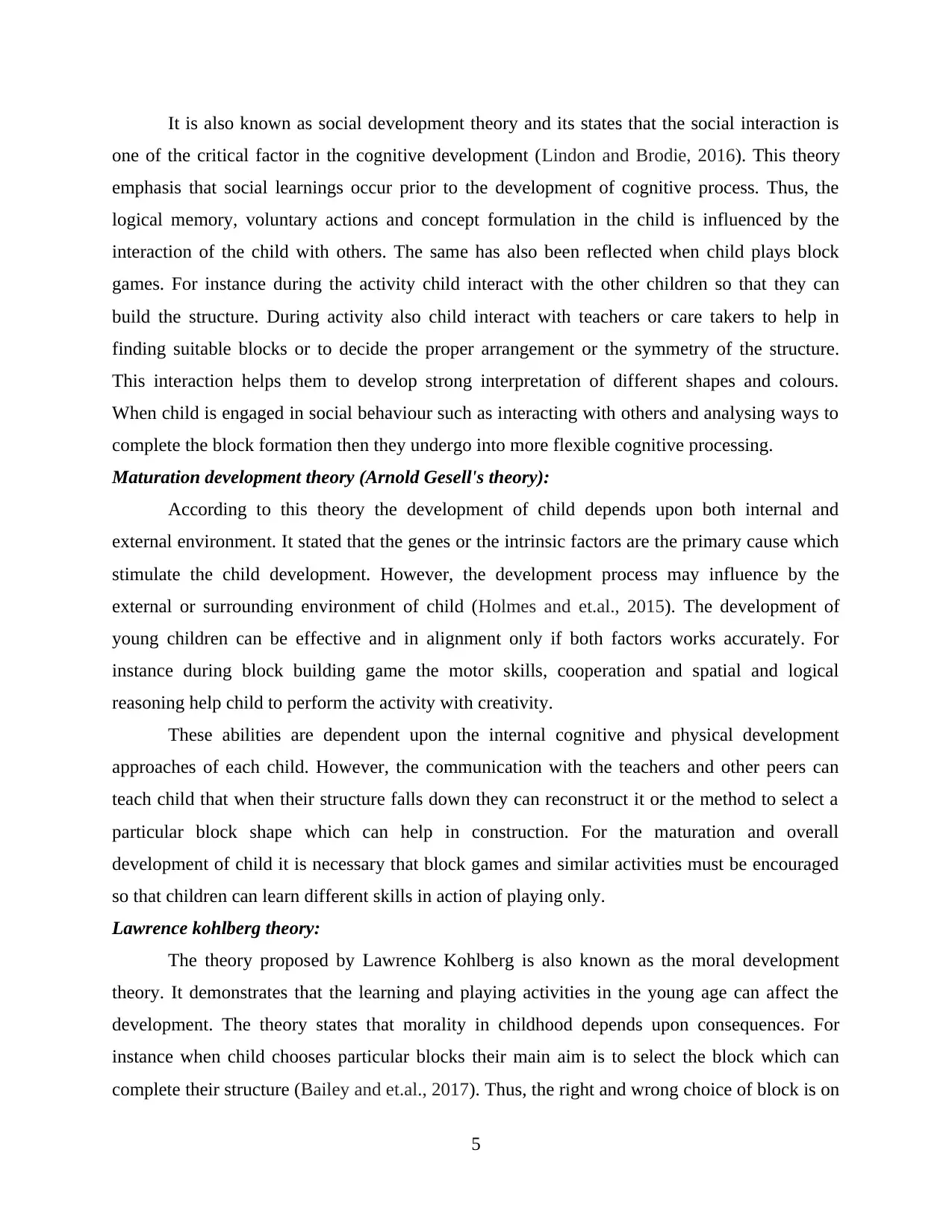
It is also known as social development theory and its states that the social interaction is
one of the critical factor in the cognitive development (Lindon and Brodie, 2016). This theory
emphasis that social learnings occur prior to the development of cognitive process. Thus, the
logical memory, voluntary actions and concept formulation in the child is influenced by the
interaction of the child with others. The same has also been reflected when child plays block
games. For instance during the activity child interact with the other children so that they can
build the structure. During activity also child interact with teachers or care takers to help in
finding suitable blocks or to decide the proper arrangement or the symmetry of the structure.
This interaction helps them to develop strong interpretation of different shapes and colours.
When child is engaged in social behaviour such as interacting with others and analysing ways to
complete the block formation then they undergo into more flexible cognitive processing.
Maturation development theory (Arnold Gesell's theory):
According to this theory the development of child depends upon both internal and
external environment. It stated that the genes or the intrinsic factors are the primary cause which
stimulate the child development. However, the development process may influence by the
external or surrounding environment of child (Holmes and et.al., 2015). The development of
young children can be effective and in alignment only if both factors works accurately. For
instance during block building game the motor skills, cooperation and spatial and logical
reasoning help child to perform the activity with creativity.
These abilities are dependent upon the internal cognitive and physical development
approaches of each child. However, the communication with the teachers and other peers can
teach child that when their structure falls down they can reconstruct it or the method to select a
particular block shape which can help in construction. For the maturation and overall
development of child it is necessary that block games and similar activities must be encouraged
so that children can learn different skills in action of playing only.
Lawrence kohlberg theory:
The theory proposed by Lawrence Kohlberg is also known as the moral development
theory. It demonstrates that the learning and playing activities in the young age can affect the
development. The theory states that morality in childhood depends upon consequences. For
instance when child chooses particular blocks their main aim is to select the block which can
complete their structure (Bailey and et.al., 2017). Thus, the right and wrong choice of block is on
5
one of the critical factor in the cognitive development (Lindon and Brodie, 2016). This theory
emphasis that social learnings occur prior to the development of cognitive process. Thus, the
logical memory, voluntary actions and concept formulation in the child is influenced by the
interaction of the child with others. The same has also been reflected when child plays block
games. For instance during the activity child interact with the other children so that they can
build the structure. During activity also child interact with teachers or care takers to help in
finding suitable blocks or to decide the proper arrangement or the symmetry of the structure.
This interaction helps them to develop strong interpretation of different shapes and colours.
When child is engaged in social behaviour such as interacting with others and analysing ways to
complete the block formation then they undergo into more flexible cognitive processing.
Maturation development theory (Arnold Gesell's theory):
According to this theory the development of child depends upon both internal and
external environment. It stated that the genes or the intrinsic factors are the primary cause which
stimulate the child development. However, the development process may influence by the
external or surrounding environment of child (Holmes and et.al., 2015). The development of
young children can be effective and in alignment only if both factors works accurately. For
instance during block building game the motor skills, cooperation and spatial and logical
reasoning help child to perform the activity with creativity.
These abilities are dependent upon the internal cognitive and physical development
approaches of each child. However, the communication with the teachers and other peers can
teach child that when their structure falls down they can reconstruct it or the method to select a
particular block shape which can help in construction. For the maturation and overall
development of child it is necessary that block games and similar activities must be encouraged
so that children can learn different skills in action of playing only.
Lawrence kohlberg theory:
The theory proposed by Lawrence Kohlberg is also known as the moral development
theory. It demonstrates that the learning and playing activities in the young age can affect the
development. The theory states that morality in childhood depends upon consequences. For
instance when child chooses particular blocks their main aim is to select the block which can
complete their structure (Bailey and et.al., 2017). Thus, the right and wrong choice of block is on
5
Paraphrase This Document
Need a fresh take? Get an instant paraphrase of this document with our AI Paraphraser
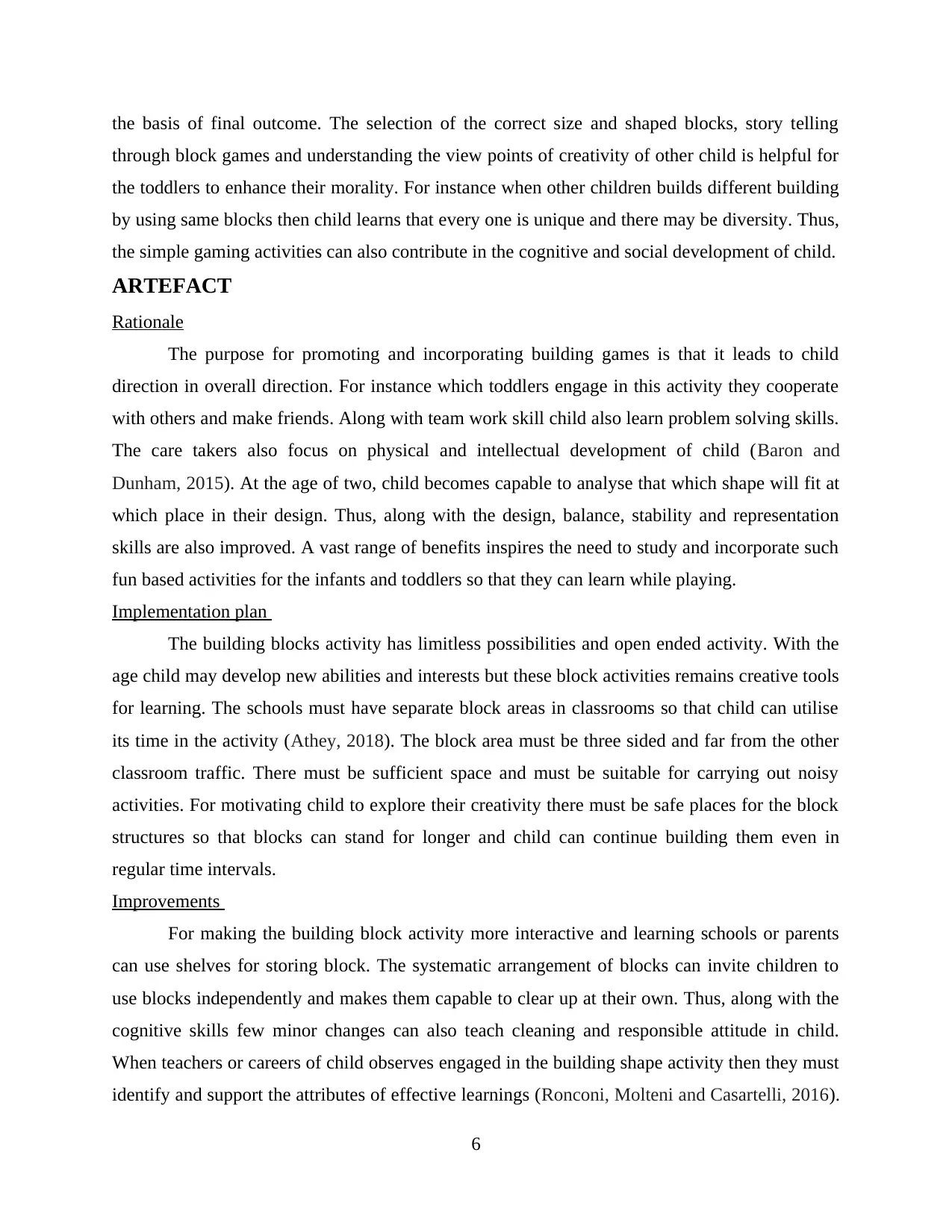
the basis of final outcome. The selection of the correct size and shaped blocks, story telling
through block games and understanding the view points of creativity of other child is helpful for
the toddlers to enhance their morality. For instance when other children builds different building
by using same blocks then child learns that every one is unique and there may be diversity. Thus,
the simple gaming activities can also contribute in the cognitive and social development of child.
ARTEFACT
Rationale
The purpose for promoting and incorporating building games is that it leads to child
direction in overall direction. For instance which toddlers engage in this activity they cooperate
with others and make friends. Along with team work skill child also learn problem solving skills.
The care takers also focus on physical and intellectual development of child (Baron and
Dunham, 2015). At the age of two, child becomes capable to analyse that which shape will fit at
which place in their design. Thus, along with the design, balance, stability and representation
skills are also improved. A vast range of benefits inspires the need to study and incorporate such
fun based activities for the infants and toddlers so that they can learn while playing.
Implementation plan
The building blocks activity has limitless possibilities and open ended activity. With the
age child may develop new abilities and interests but these block activities remains creative tools
for learning. The schools must have separate block areas in classrooms so that child can utilise
its time in the activity (Athey, 2018). The block area must be three sided and far from the other
classroom traffic. There must be sufficient space and must be suitable for carrying out noisy
activities. For motivating child to explore their creativity there must be safe places for the block
structures so that blocks can stand for longer and child can continue building them even in
regular time intervals.
Improvements
For making the building block activity more interactive and learning schools or parents
can use shelves for storing block. The systematic arrangement of blocks can invite children to
use blocks independently and makes them capable to clear up at their own. Thus, along with the
cognitive skills few minor changes can also teach cleaning and responsible attitude in child.
When teachers or careers of child observes engaged in the building shape activity then they must
identify and support the attributes of effective learnings (Ronconi, Molteni and Casartelli, 2016).
6
through block games and understanding the view points of creativity of other child is helpful for
the toddlers to enhance their morality. For instance when other children builds different building
by using same blocks then child learns that every one is unique and there may be diversity. Thus,
the simple gaming activities can also contribute in the cognitive and social development of child.
ARTEFACT
Rationale
The purpose for promoting and incorporating building games is that it leads to child
direction in overall direction. For instance which toddlers engage in this activity they cooperate
with others and make friends. Along with team work skill child also learn problem solving skills.
The care takers also focus on physical and intellectual development of child (Baron and
Dunham, 2015). At the age of two, child becomes capable to analyse that which shape will fit at
which place in their design. Thus, along with the design, balance, stability and representation
skills are also improved. A vast range of benefits inspires the need to study and incorporate such
fun based activities for the infants and toddlers so that they can learn while playing.
Implementation plan
The building blocks activity has limitless possibilities and open ended activity. With the
age child may develop new abilities and interests but these block activities remains creative tools
for learning. The schools must have separate block areas in classrooms so that child can utilise
its time in the activity (Athey, 2018). The block area must be three sided and far from the other
classroom traffic. There must be sufficient space and must be suitable for carrying out noisy
activities. For motivating child to explore their creativity there must be safe places for the block
structures so that blocks can stand for longer and child can continue building them even in
regular time intervals.
Improvements
For making the building block activity more interactive and learning schools or parents
can use shelves for storing block. The systematic arrangement of blocks can invite children to
use blocks independently and makes them capable to clear up at their own. Thus, along with the
cognitive skills few minor changes can also teach cleaning and responsible attitude in child.
When teachers or careers of child observes engaged in the building shape activity then they must
identify and support the attributes of effective learnings (Ronconi, Molteni and Casartelli, 2016).
6
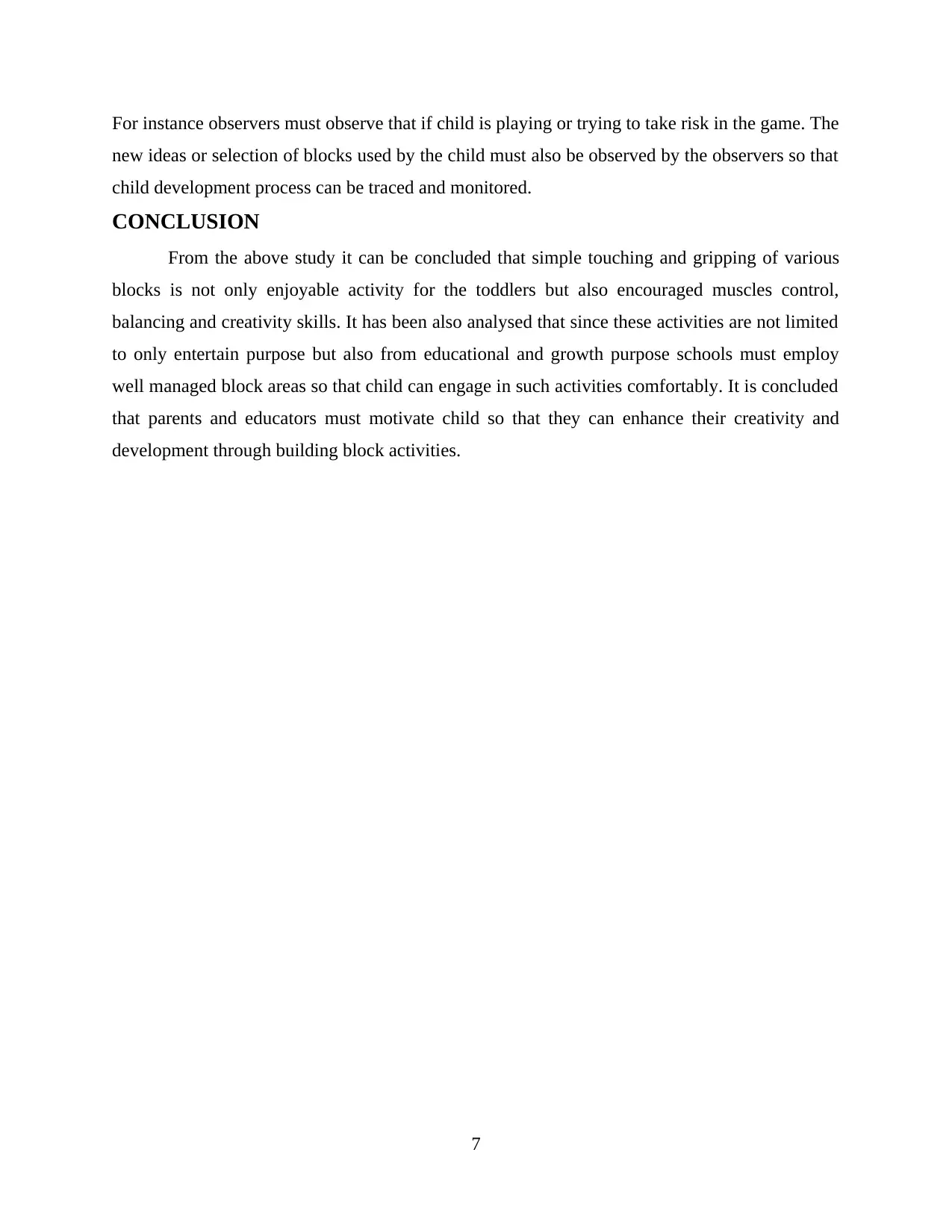
For instance observers must observe that if child is playing or trying to take risk in the game. The
new ideas or selection of blocks used by the child must also be observed by the observers so that
child development process can be traced and monitored.
CONCLUSION
From the above study it can be concluded that simple touching and gripping of various
blocks is not only enjoyable activity for the toddlers but also encouraged muscles control,
balancing and creativity skills. It has been also analysed that since these activities are not limited
to only entertain purpose but also from educational and growth purpose schools must employ
well managed block areas so that child can engage in such activities comfortably. It is concluded
that parents and educators must motivate child so that they can enhance their creativity and
development through building block activities.
7
new ideas or selection of blocks used by the child must also be observed by the observers so that
child development process can be traced and monitored.
CONCLUSION
From the above study it can be concluded that simple touching and gripping of various
blocks is not only enjoyable activity for the toddlers but also encouraged muscles control,
balancing and creativity skills. It has been also analysed that since these activities are not limited
to only entertain purpose but also from educational and growth purpose schools must employ
well managed block areas so that child can engage in such activities comfortably. It is concluded
that parents and educators must motivate child so that they can enhance their creativity and
development through building block activities.
7
⊘ This is a preview!⊘
Do you want full access?
Subscribe today to unlock all pages.

Trusted by 1+ million students worldwide
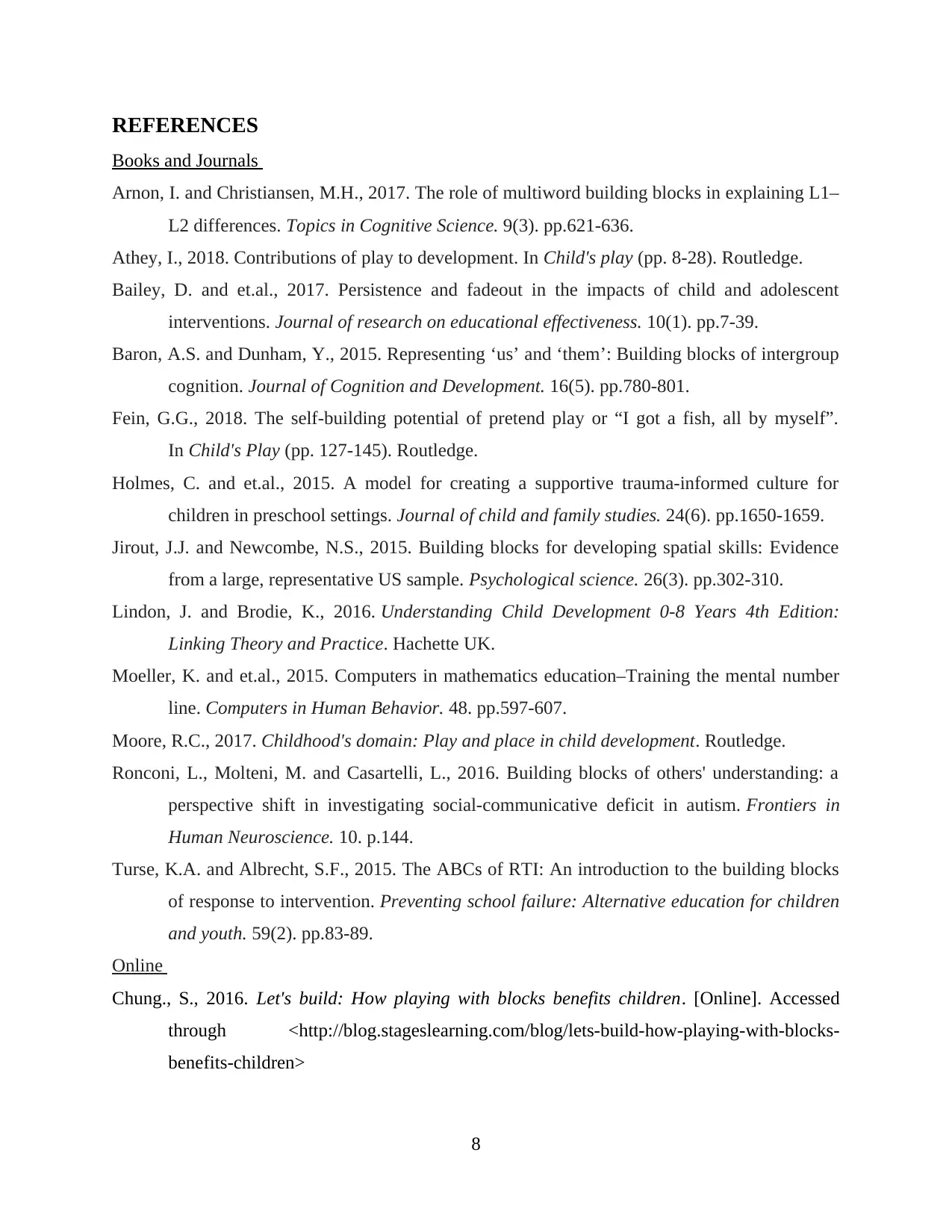
REFERENCES
Books and Journals
Arnon, I. and Christiansen, M.H., 2017. The role of multiword building blocks in explaining L1–
L2 differences. Topics in Cognitive Science. 9(3). pp.621-636.
Athey, I., 2018. Contributions of play to development. In Child's play (pp. 8-28). Routledge.
Bailey, D. and et.al., 2017. Persistence and fadeout in the impacts of child and adolescent
interventions. Journal of research on educational effectiveness. 10(1). pp.7-39.
Baron, A.S. and Dunham, Y., 2015. Representing ‘us’ and ‘them’: Building blocks of intergroup
cognition. Journal of Cognition and Development. 16(5). pp.780-801.
Fein, G.G., 2018. The self-building potential of pretend play or “I got a fish, all by myself”.
In Child's Play (pp. 127-145). Routledge.
Holmes, C. and et.al., 2015. A model for creating a supportive trauma-informed culture for
children in preschool settings. Journal of child and family studies. 24(6). pp.1650-1659.
Jirout, J.J. and Newcombe, N.S., 2015. Building blocks for developing spatial skills: Evidence
from a large, representative US sample. Psychological science. 26(3). pp.302-310.
Lindon, J. and Brodie, K., 2016. Understanding Child Development 0-8 Years 4th Edition:
Linking Theory and Practice. Hachette UK.
Moeller, K. and et.al., 2015. Computers in mathematics education–Training the mental number
line. Computers in Human Behavior. 48. pp.597-607.
Moore, R.C., 2017. Childhood's domain: Play and place in child development. Routledge.
Ronconi, L., Molteni, M. and Casartelli, L., 2016. Building blocks of others' understanding: a
perspective shift in investigating social-communicative deficit in autism. Frontiers in
Human Neuroscience. 10. p.144.
Turse, K.A. and Albrecht, S.F., 2015. The ABCs of RTI: An introduction to the building blocks
of response to intervention. Preventing school failure: Alternative education for children
and youth. 59(2). pp.83-89.
Online
Chung., S., 2016. Let's build: How playing with blocks benefits children. [Online]. Accessed
through <http://blog.stageslearning.com/blog/lets-build-how-playing-with-blocks-
benefits-children>
8
Books and Journals
Arnon, I. and Christiansen, M.H., 2017. The role of multiword building blocks in explaining L1–
L2 differences. Topics in Cognitive Science. 9(3). pp.621-636.
Athey, I., 2018. Contributions of play to development. In Child's play (pp. 8-28). Routledge.
Bailey, D. and et.al., 2017. Persistence and fadeout in the impacts of child and adolescent
interventions. Journal of research on educational effectiveness. 10(1). pp.7-39.
Baron, A.S. and Dunham, Y., 2015. Representing ‘us’ and ‘them’: Building blocks of intergroup
cognition. Journal of Cognition and Development. 16(5). pp.780-801.
Fein, G.G., 2018. The self-building potential of pretend play or “I got a fish, all by myself”.
In Child's Play (pp. 127-145). Routledge.
Holmes, C. and et.al., 2015. A model for creating a supportive trauma-informed culture for
children in preschool settings. Journal of child and family studies. 24(6). pp.1650-1659.
Jirout, J.J. and Newcombe, N.S., 2015. Building blocks for developing spatial skills: Evidence
from a large, representative US sample. Psychological science. 26(3). pp.302-310.
Lindon, J. and Brodie, K., 2016. Understanding Child Development 0-8 Years 4th Edition:
Linking Theory and Practice. Hachette UK.
Moeller, K. and et.al., 2015. Computers in mathematics education–Training the mental number
line. Computers in Human Behavior. 48. pp.597-607.
Moore, R.C., 2017. Childhood's domain: Play and place in child development. Routledge.
Ronconi, L., Molteni, M. and Casartelli, L., 2016. Building blocks of others' understanding: a
perspective shift in investigating social-communicative deficit in autism. Frontiers in
Human Neuroscience. 10. p.144.
Turse, K.A. and Albrecht, S.F., 2015. The ABCs of RTI: An introduction to the building blocks
of response to intervention. Preventing school failure: Alternative education for children
and youth. 59(2). pp.83-89.
Online
Chung., S., 2016. Let's build: How playing with blocks benefits children. [Online]. Accessed
through <http://blog.stageslearning.com/blog/lets-build-how-playing-with-blocks-
benefits-children>
8
Paraphrase This Document
Need a fresh take? Get an instant paraphrase of this document with our AI Paraphraser

What Preschoolers Can Learn From Block Play. 2018. [Online]. Accessed through
<https://parenting.firstcry.com/articles/what-preschoolers-can-learn-from-block-play/>
9
<https://parenting.firstcry.com/articles/what-preschoolers-can-learn-from-block-play/>
9

10
⊘ This is a preview!⊘
Do you want full access?
Subscribe today to unlock all pages.

Trusted by 1+ million students worldwide
1 out of 15
Related Documents
Your All-in-One AI-Powered Toolkit for Academic Success.
+13062052269
info@desklib.com
Available 24*7 on WhatsApp / Email
![[object Object]](/_next/static/media/star-bottom.7253800d.svg)
Unlock your academic potential
Copyright © 2020–2025 A2Z Services. All Rights Reserved. Developed and managed by ZUCOL.




